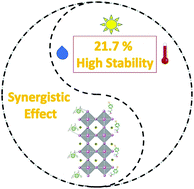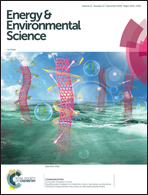Suppressing defects through the synergistic effect of a Lewis base and a Lewis acid for highly efficient and stable perovskite solar cells†
Abstract
Achieving long-term operational stability at a high efficiency level for perovskite solar cells is the most challenging issue toward commercialization of this emerging photovoltaic technology. Here, we investigated the cooperation of a Lewis base and a Lewis acid by combining commercial bis-PCBM mixed isomers as the Lewis acid in the antisolvent and N-(4-bromophenyl)thiourea (BrPh-ThR) as the Lewis base in the perovskite solution precursor. The combination of the Lewis base and the Lewis acid synergistically passivates Pb2+ and PbX3− antisite defects, enlarges the perovskite grain size, and improves charge-carrier separation and transport, leading to improved device efficiency from 19.3% to 21.7%. In addition, this Lewis base and acid combination also suppresses moisture incursion and passivates pinholes generated in the hole-transporting layer. The unsealed devices remained at 93% of the initial efficiency value in ambient air (10–20% relative humidity) after 3600 h at 20–25 °C and dropped by 10% after 1500 h under continuous operation at 1-sun illumination and 55 °C in nitrogen with maximum power-point tracking.



 Please wait while we load your content...
Please wait while we load your content...
